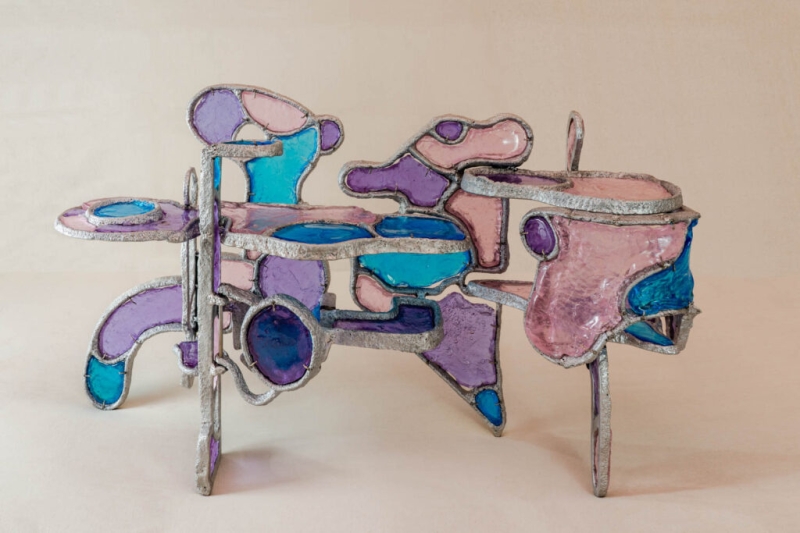Contents
- 1 See These Sustainable Works At the Odunpazarı Modern Museum
- 1.1 Drill Vases (2016) by Studio EO
- 1.2 Masa (2022) by VAUST
- 1.3 Epidrome (2020) by touche-touche
- 1.4 Vases (2022) by Bertrand Fompeyrine
- 1.5 Mass (2022) by Odd Matter
- 1.6 Latent Longing (2021) by Misha Kahn
- 1.7 Scary Vase (2022) by Faye Hadfield
- 1.8 Ova (2023) by Studio Yellowdot
- 1.9 Chasing Wild Goats (2024) by Guido Cassaretto
- 1.10 Pillow Pillow (2019) by Schimmel & Schweikle
Latent Longing. Photography courtesy of Misha Khan.
Hosted at Odunpazarı Modern Museum (OMM) in the city of Eskişehir, Turkey, “Creatures of Comfort” is a brand new showcase that explores the fascinating interplay between design and nature, examining how these seemingly disparate elements coexist in both contemporary art and everyday life. Curated by OMM’s creative director İdil Tabanca, the exhibition, which will run until July 19, 2025, boasts an international roster of artists and designers. It also presents works that challenge conventional notions of functionality by infusing everyday objects with biophilic elements and emotional depth, inviting the natural world back into artificial, urban spaces through new approaches and ideas that celebrate the organic over the sterile and mechanistic. From an amorphic stained glass sculpture to a bright pink cabinet inspired by egg clusters of apple snails, here are just some of the highlights on display at the Odunpazarı Modern Museum’s organic exhibit “Creatures of Comfort.”
See These Sustainable Works At the Odunpazarı Modern Museum
Drill Vases (2016) by Studio EO

Drill Vase #33. Photography courtesy of Studio EO.
Created by Stockholm-based Studio EO, founded in 2013 by Erik Olovsson, Drill Vases is a series that demonstrates an intuitive, experimental approach juxtaposing smooth glass against the roughness of natural marble. Utilizing discarded marble collected from Italy’s Carrara region as bases, and a hammer and chisel initial treatment before drilling openings for the hand-blown cylindrical glass vases, this deliberate pairing highlights fundamental oppositions of transparency versus opacity; durability contrasted against fragility; raw, crude textuality against a glossy, refined finish; and order and chaos.
Masa (2022) by VAUST
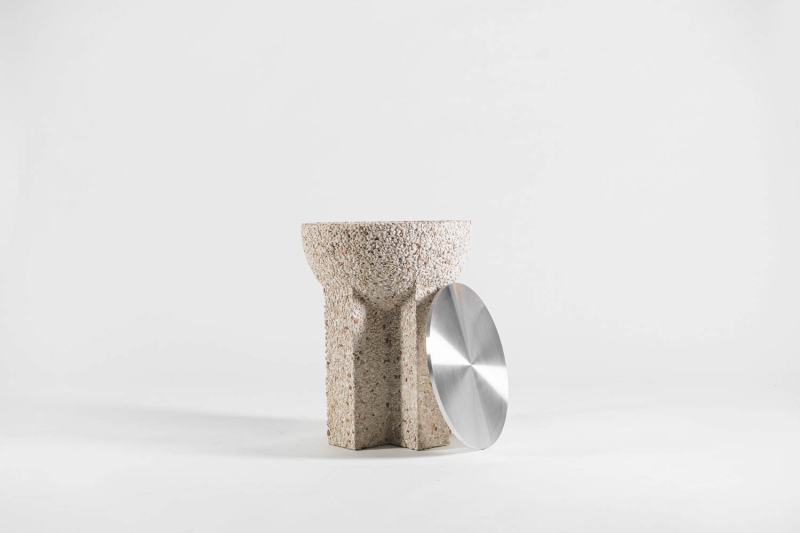
Masa. Photography courtesy of VAUST.
Part of the Total Exposure series, Masa comes from VAUST, a Berlin-based interior design studio formed by Joern Scheipers and David Kosock, and exemplifies the duo’s dedication to unconventional thinking, distinctive aesthetics and artistic design. Referencing common geometric patterns and minimalist architectural forms reminiscent of Greco-Roman pillars, a cut-off sphere emerges from the rigidity of the cross-column stand, capped by an aluminum disc on its topmost surface. Through the addition of storage space, the object is rendered multi-functional, while the marble gravel base provides deliberate weight.
Epidrome (2020) by touche-touche
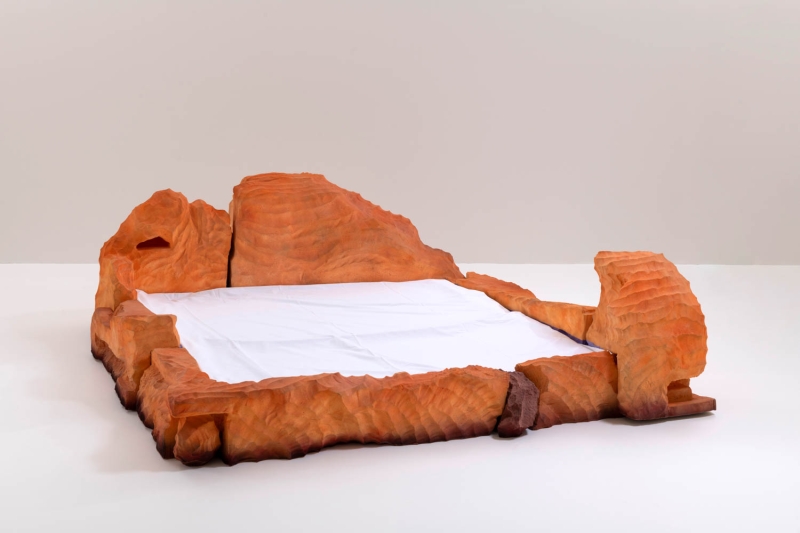
Epidrome. Photography courtesy of touche-touche.
Epidrome—made by Théo Demans and Carolin Gieszner of Belgian firm touche-touche—centers a comfortable mattress in the middle of hard ‘rock’, creating a soft, safe shelter to rest. The roughness of the bed frame contrasts starkly with the cosiness of the mattress itself, combining primal aesthetics with contemporary comforts in a commentary on the evolution of sleep, a vital human need that remains the same despite the objects accommodating it changing throughout time. The piece highlights the dichotomy between our primitive nature and our constant search for comfort.
Vases (2022) by Bertrand Fompeyrine
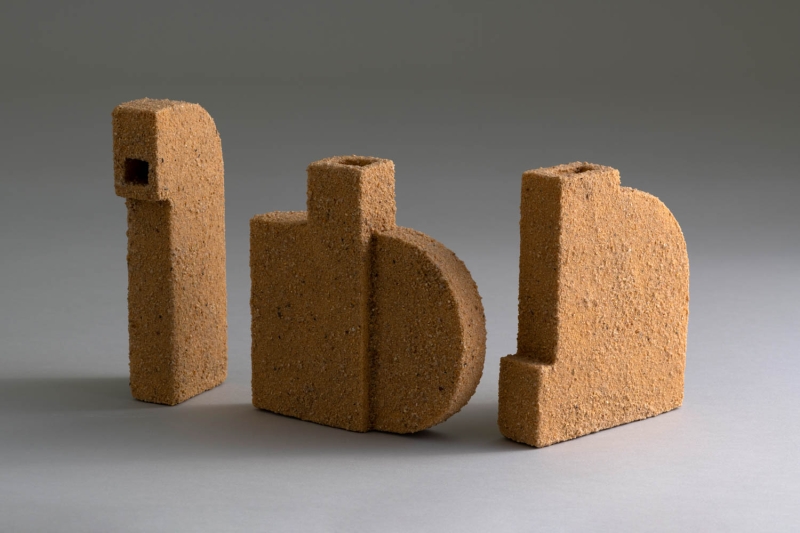
Gruissan. Photography courtesy of Bertrand Fompeyrine.
French designer and photographer Bertrand Fompeyrine’s Vases series combines sand gathered from his own personal travels with polystyrene waste found on streets and construction sites. By layering these materials together, he repurposes this discarded matter while emphasizing its potential for creating a diverse variety of textures and colors. Instead of believing in limitless resources, Fompeyrine focuses on creative boundaries and the constraints they impose, sparking innovation and generating contrasting sensory experiences through the blending of natural versus artificial materials.
Mass (2022) by Odd Matter
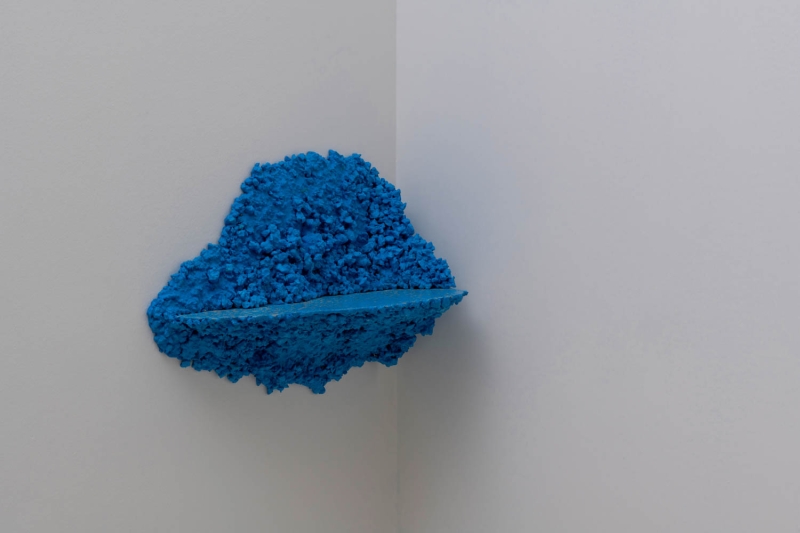
Mass Shelf. Photography courtesy of Odd Matter.
Designed by Rotterdam-based design studio Odd Matter, founded by Els Woldhek and Georgi Manassiev, Mass is a series of shelves that explore an artificial world through natural materials, prompting an examination of traditional design and the potential for new possibilities. By blending together cork granulate and alpha crystalline gypsum, the soft texture of the cork interacts with gypsum’s resilience, giving rise to new structures that mimic natural formations. By highlighting the organic physical properties of cork granulate, the artists adapt an unconventional material to an everyday object to create a novel design.
Latent Longing (2021) by Misha Kahn
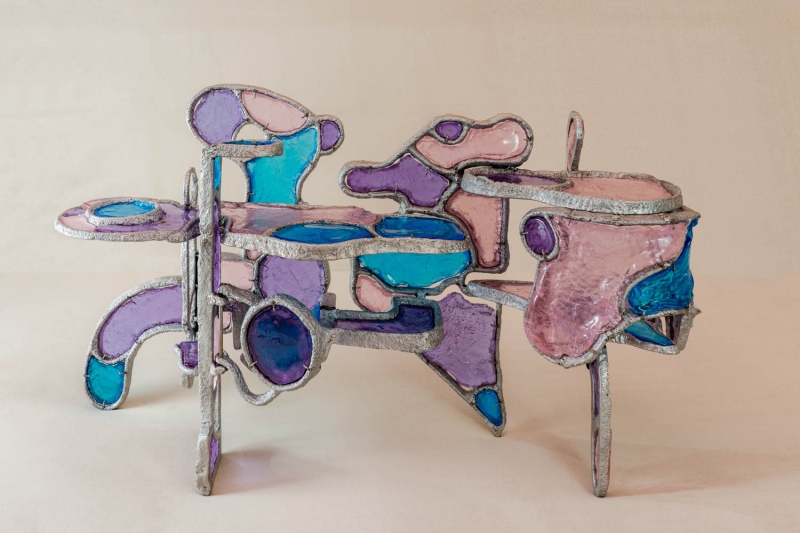
Latent Longing. Photography courtesy of Misha Kahn.
American designer Misha Kahn’s Latent Longing is formed from conjoined elements of amorphic stained glass and metal frames, producing clusters of metaphorical microorganisms or dividing cells, evoking growth. Kahn’s unconventional approach and abstract shapes take the millennia-old technique of stained glass and anchor it within a contemporary practice, both methodologically and conceptually.
Scary Vase (2022) by Faye Hadfield
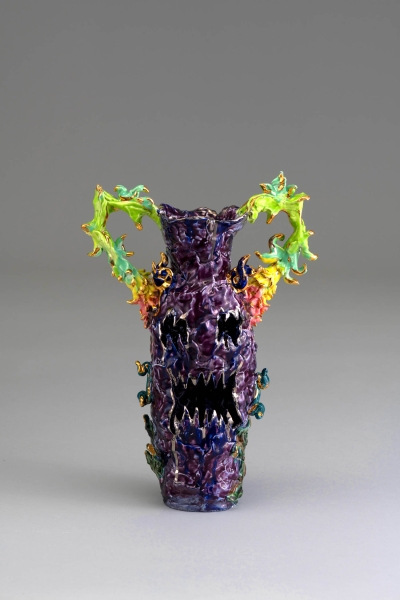
Scary Vase in Tropical. Photography courtesy of Faye Hadfield.
From British ceramicist Faye Hadfield, Scary Vase manifests an intriguingly eerie aspect into an otherwise simple household object with its uncanny visage. While traditional in form, its complex and colorful gilded design recalls both the Baroque and Rococo styles of the 17th and 18th centuries. With sharp teeth and hollow eye-sockets, this modern day grotesque piece appears as if it’s straight out of a gothic horror tale, instantly provoking a sense of intrigue and uncanniness, inviting the viewer to step beyond the confines of their comfort zone and engage emotionally with the strange subject.
Ova (2023) by Studio Yellowdot
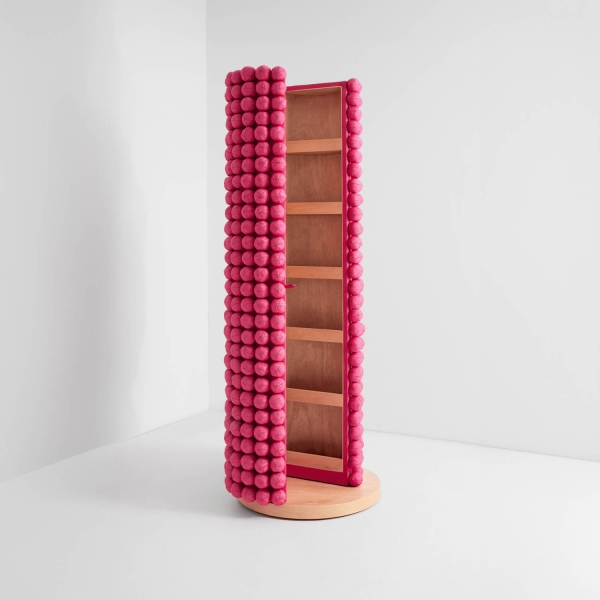
Ova Pink. Photography courtesy of Yellowdot.
The Ova series by multidisciplinary design studio Yellowdot, founded by Dilara Kan Hon and Bodin Hon, and based between Istanbul and Hong Kong, is a visual ode to the vivid colors and striking patterns of nature. Inspired by budding flowers and the bright pink egg clusters of apple snails, this cabinet reflects the vitality, fertility and creativity of nature, embodied in its brightly colored, hand-woven semi-silk fabric—colloquially known in Turkey as ‘kutnu’—that has been woven and dyed using the same techniques that have been in use since the 16th century. Once used in Ottoman palace furniture and garments, the material has been handsewn by local artisans into more than 500 individual shapes and then upholstered to completely cover the cabinet’s walls.
Chasing Wild Goats (2024) by Guido Cassaretto
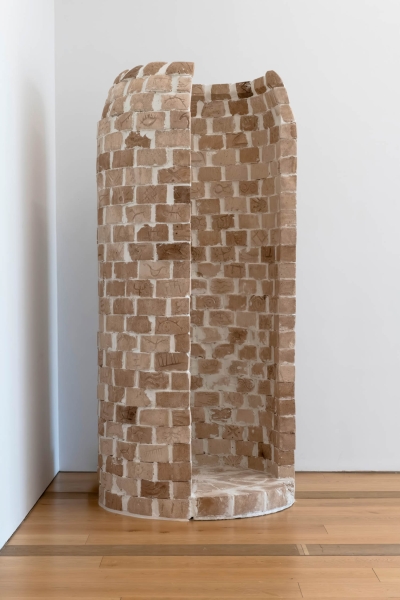
Chasing Wild Goats. Photography courtesy of Guido Casaretto.
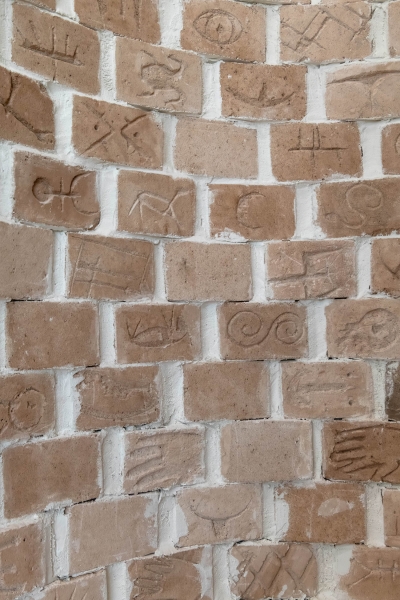
Chasing Wild Goats. Photography courtesy of Guido Casaretto.
In Chasing Wild Goats, Turkish artist Guido Casaretto replicates the carved symbols and shelter creations practices of Neolithic hunter-gatherers found at archeological sites around Karahan Tepe and Çatalhöyük. Although the meanings of some of these symbols emulated on the piece’s brickwork are obscure today, others clearly illustrate various universal icons: the Sun, animals, waterways, handprints, and constellations. These hundreds of visual markers—created by primitive communities, long before the advent of writing—are reinterpreted today as methods of note-taking, transmitting information to future generations.
Pillow Pillow (2019) by Schimmel & Schweikle
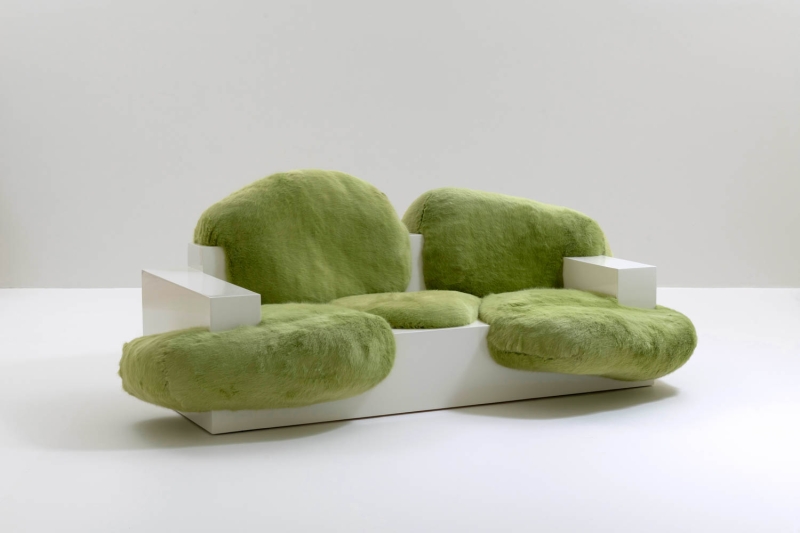
Pillow Couch Photography courtesy of Schimmel & Schweikle.
Produced by Schimmel & Schweikle—founded by Janne Schimmel and Moreno Schweikle, who both live and work between the Netherlands, Germany and Belgium—the Pillow Pillow series consists of pieces designed with 3D modeling programs and then transformed into tangible objects using wood and faux fur, alongside other materials, to create textural contrasts between sharp lines and soft upholstery. Despite the deeply ingrained use of contemporary technology in their creation, the works appear very organic in their execution. Their designs evoke images of wild plants or mosses that assimilate man-made objects, suggesting the gradual proliferation and ultimate supremacy of nature over modernity, or even humanity.

